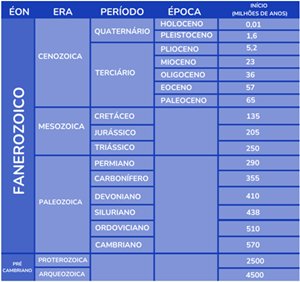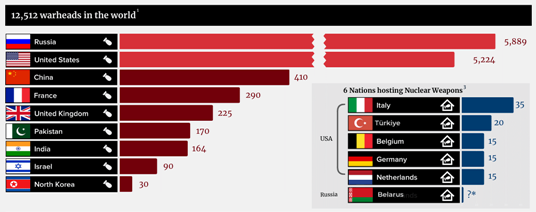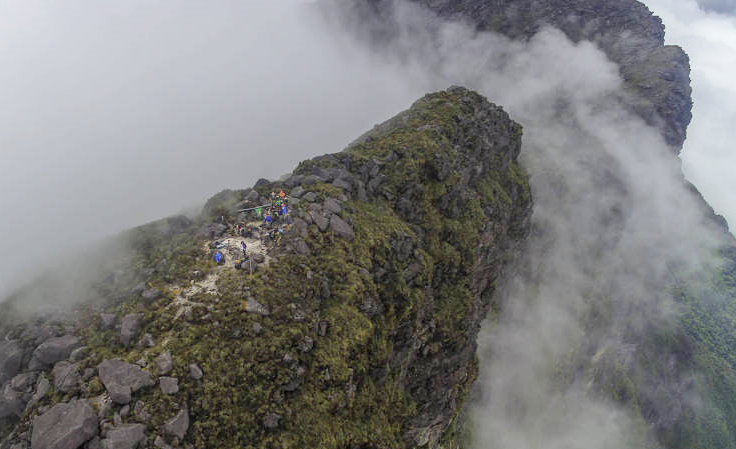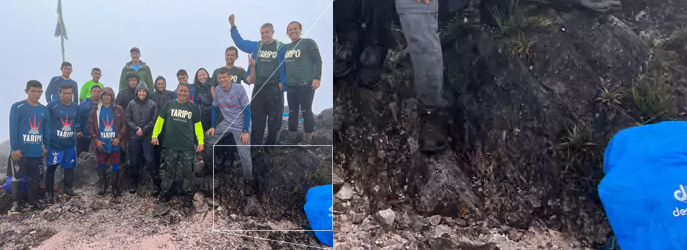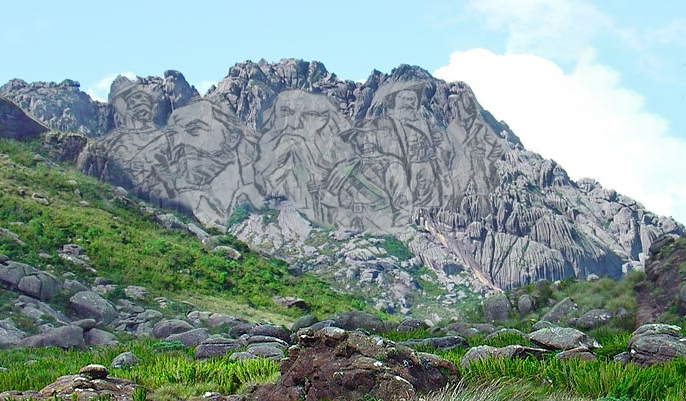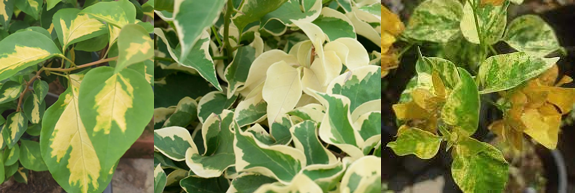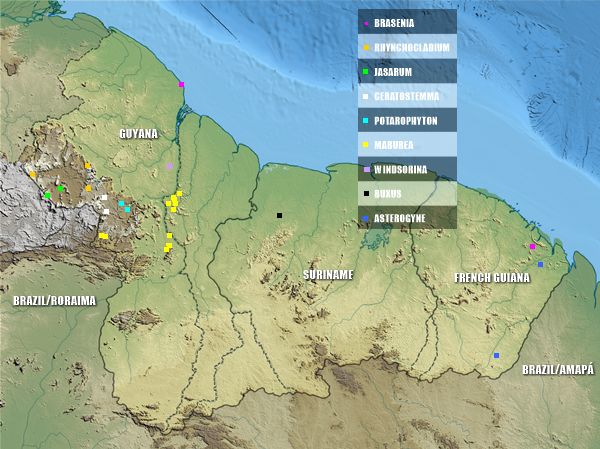Não de muito: um período geológico e um elemento químico batizados em referência ao nosso país, armas nucleares e bases militares no exterior.
PERIODO GEOLÓGICO
Nenhum período geológico, até nível de series, tem nome dado em referência a Brasil ou um elemento seu.
Os nomes das eras geológicas têm origens variadas, muitas vezes derivadas de características geológicas significativas ou de locais onde foram inicialmente identificadas. Todos são nomes de radicais gregos exceto Pré-Cambriano, pois Cambria era um nome antigo para atual Gales. Dos 12 períodos dentro das eras, todos se baseiam em nomes de objetos ou termos genéricos, exceto os citados a seguir.
Cambriano: Este período foi nomeado após Cambria, o nome latino para Gales.
Ordoviciano: O nome vem da tribo Ordovices, uma tribo celta que habitava a região de Gales.
Siluriano: Nomeado após os Silures, uma antiga tribo celta que habitava a região central do País de Gales.
Devoniano: Derivado da região de Devonshire, na Inglaterra.
Permiano: Nomeado após a província de Perm, na Rússia.
Jurássico: Nomeado após a região de Jura, nos Alpes franceses.
No estágio inferior - séries - há varias referências a regiões de vários países do mundo, com destaque para EUA (3), China (3), Rússia (1), entre outros. Não há referência a nenhum país da América Latina nem África. Para listagem completa destes períodos, veja Wikipedia/Geologic Time Scale.
ELEMENTO QUIMICO
Os nomes dos elementos químicos podem ser atribuídos de várias maneiras, mas geralmente seguem certas convenções e padrões estabelecidos pela União Internacional de Química Pura e Aplicada (IUPAC) e pela comunidade científica internacional. Aqui está uma lista dos elementos químicos batizados em referência a entes geográficos (Superinteressante, 2023) - nenhum faz referência ao Brasil.
Magnesio (Magnesia, Grécia)
Escândio (Escandinávia, Europe)
Manganês (também Magnesia, Grécia)
Cobre (Chipre)
Gálio (Gália, França)
Germânio (Alemanha)
Estrôncio (Vila de Strontian, na Escócia)
Ítrio (Cidade de Ytterby, na Suécia)
Rutênio (Ruthenia, antigo nome das terras da Rússia)
Samário (deriva do mineral samarskita, batizado em homenagem ao geólogo russo Vassili Samarsky-Bykhovets)
Európio (Europa)
Gadolínio (de gadolinita, batizado em homenagem ao cientista nórdico Johan Gadolin)
Térbio (Ytterby, na Suécia)
Holmio (Holmia, antigo nome da cidade de Estocolmo)
Érbio (Ytterby, na Suécia)
Túlio (Thule, antigo termo usado para se referir à Escandinávia)
Itérbio (Ytterby, na Suécia)
Lutécio (Lutetia, antigo nome romano da cidade de Paris)
Háfnio (Háfnia, o antigo nome da cidade de Copenhague)
Rênio (Rio Reno, que cruza a Alemanha)
Polônio (Polônia, terra natal de Marie Curie)
Frâncio (França)
Amerício (America)
Cúrio (Marie Curie (1867 – 1934) e Pierre Curie (1859 – 1906), químicos poloneses)
Berquélio (Berkeley, EUA)
Californio (Califórnia, EUA)
Einstênio (Albert Einstein, físico alemão)
Férmio (Enrico Fermi, físico italiano)
Mendelévio (Dmitri Mendeleev, físico russo)
Nobélio (Alfred Nobel, químico e engenheiro sueco)
Laurêncio (Ernest Lawrence, físico estadunidense)
Ruthefordio (Ernest Rutherford, físico neozelandes)
Dubnio (Dubna, Rússia)
Seabórgio (Glenn Theodore Seaborg, químico estadunidense)
Bohrio (Niels Bohr, físico dinamarquês)
Hássio (Hasse, na Alemanha)
Meitnério (Lise Meitner, física austríaca)
Damstádio (Darmstadt, na Alemanha)
Roentgenio (Wilhelm Röntgen, físico alemão)
Copernício (Nicolau Copérnico, estudioso polonês)
Nihonio (Japão)
Fleróvio (Georgy Flyorov, físico soviético/russo)
Moscóvio (Moscou, Rússia)
Livermório (Lawrence Livermore National Laboratory, laboratório da Califórnia)
Tenessino (Tennessee, EUA)
Oganessônio (Yuri Oganessian, físico soviético/russo)
De todos estes registros, os únicos que não fezem refewrência a países inteiramente europeus ou pesquisadores seus são 17: Cobre, Rutênio, Samário, Amerício, Berquélio, Califórnio, Mendelévio, Laurêncio, Rutherfordio, Dubnio, Seabórgio, Nihonio, Fleróvio, Moscóvio, Livermório, Tenessino e Oganessônio - destes, seis são referência aos EUA (2 estados, 1 cidade, 1 instituto, 2 pesquisadores), sete em referência a Rússia (1 nome genérico, 4 pesquisadores e 2 cidades), e Chipre, Nova Zealândia, Japão e América como um todo, uma referência cada.
ARMA NUCLEAR
Países com armas nucleares detêm um poder estratégico significativo no cenário global. Ter um arsenal nuclear confere a esses países uma posição de influência e dissuasão, principalmente em termos de segurança nacional e geopolítica. Aqui estão algumas razões para a importância das armas nucleares para um país:
1. Dissuasão de Agressão: As armas nucleares servem como um poderoso elemento dissuasório contra agressores potenciais. A ameaça de retaliação nuclear pode desencorajar outros países de lançar ataques contra um país nuclear.
2. Segurança Nacional: O arsenal nuclear fortalece a segurança nacional de um país, garantindo sua capacidade de resposta a qualquer ameaça existencial. Isso cria uma espécie de "guarda-chuva nuclear" para proteger o país contra ameaças externas.
3. Influência Global: Possuir armas nucleares confere prestígio e influência no cenário global. Isso pode ser utilizado como moeda de troca em negociações diplomáticas e como uma forma de afirmação de poder.
4. Equilíbrio de Poder: A posse de armas nucleares por vários países contribui para um equilíbrio de poder, desencorajando conflitos diretos entre grandes potências e promovendo a estabilidade global.
Atualmente, os principais países com arsenais nucleares são: Rússia (5889), Estados Unidos (5224), China (410), França (290), Reino Unido (225), Paquistão (170), Índia (164), Israel (unknown) e Coreia do Norte (embora não oficialmente reconhecida por todos os países).
BASE MILITAR ESTRANGEIRA
A instalação de bases militares no exterior permite a um país projetar poder, por exemplo, para conduzir guerra expedicionária e, assim, influenciar eventos no exterior. Dependendo de seu tamanho e infraestrutura, elas podem ser usadas como áreas de preparação ou para suporte logístico, de comunicações e de inteligência. Muitos conflitos ao longo da história moderna resultaram na instalação de bases militares no exterior em grande número por parte das potências mundiais; e essas bases têm ajudado os países que as estabeleceram a alcançar objetivos políticos e militares.
Ao todo no mundo, 18 países projetam poder com presenças militares articuladas fora de seu território (Wikipedia). Todos os países que tem bases fora do seu território são da Eurásia exceto EUA e Austrália. Por outro lado, nas Américas, apenas os EUA posseum base fora do país, e os únicos que tem bases em seu território são Cuba (China e EUA um cada), Bahamas (EUA), Belize (Reino Unido), Honduras (EUA) e Antilhas Holandesas (EUA e Neterlands 1 cada).
